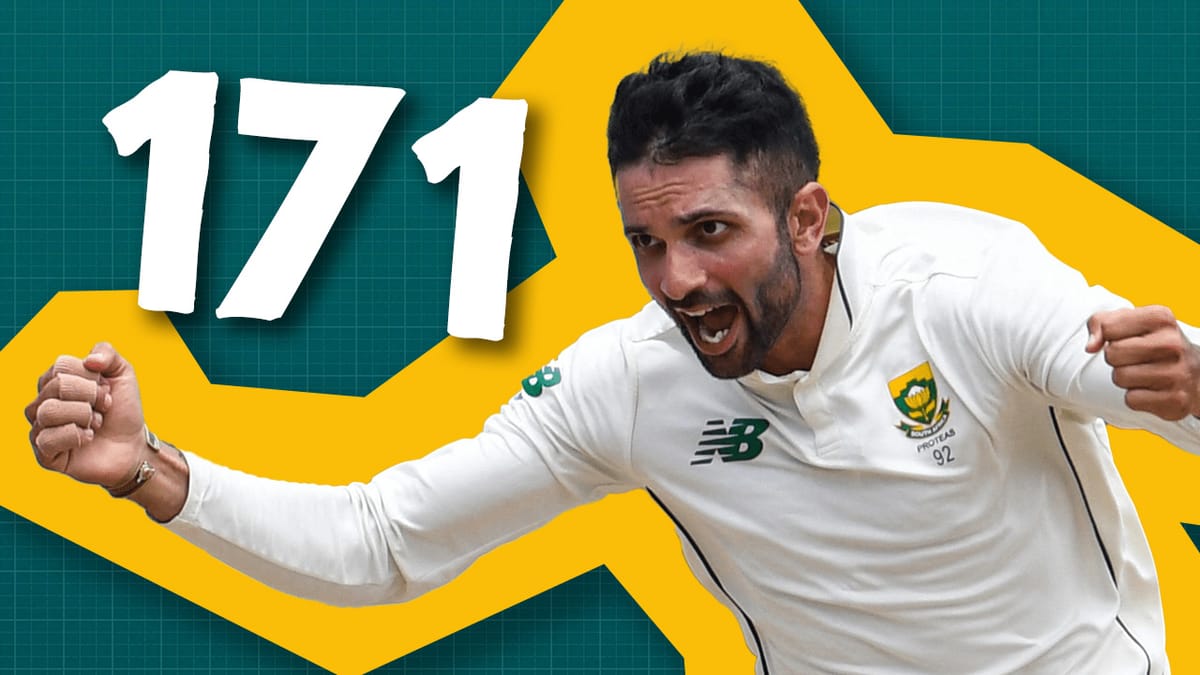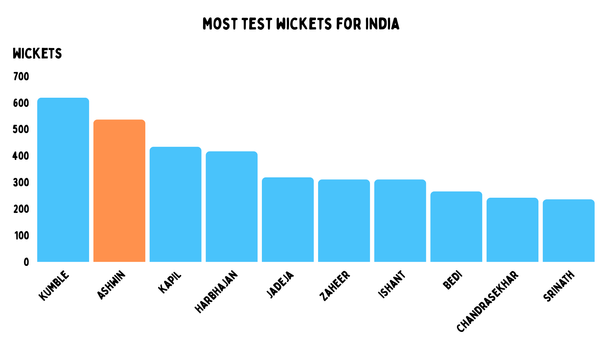Maharaj backed himself, 171 times
Legend has it that Kiran More looked at two-year-old Maharaj’s palms and predicted, "This child will be a cricketer."

Download Hitwicket FREE for iOS/Android and build your dream team!
Steve Smith stood his ground and asked umpire Aleem Dar to send the decision upstairs to the third umpire. The Australian had danced down the track to a flat Keshav Maharaj delivery on middle and off. Smith meant to nudge the ball but missed, and was struck on the pads.
The South African players stood around Maharaj for an eternity while the third umpire, Richard Kettleborough, studied the footage. When he was done, the graphics showed two red lights and one orange. The ball had pitched just outside off, struck Smith in-line, and clipped the stumps. Maharaj had his maiden Test wicket.

Technically it made sense, a left-arm bowler spinning the ball away from a right-hander who drags the ball to leg. But it was also a South African tweaker going up against one of the best batters in the world. Most people would have expected Smith to have the upper hand in this contest.
**************************************************************
Legend has it that Kiran More looked at two-year-old Maharaj’s palms and predicted, "This child will be a cricketer."
It’s hard to know what the former Indian cricketer saw in the toddler’s palms. After all, he did not use an exact science. People in certain cultures look at a toddler’s palms to determine paternity. Maybe he just went off the fact that Maharaj’s palms resembled his father’s, Athmanand, a former first-class cricketer for Natal B.
Athmanand’s career didn’t peak in the lower leagues because he lacked talent and ability. Sport was segregated and this was as good as it got for him. That didn’t diminish his love for the game. When cricket opened up for everyone in the 1990s, Athmanand decided Keshav would achieve what he couldn't, and More’s comment strengthened his resolve.
His father gave him an English willow bat at five, literally passing the baton. However, despite growing up in an environment of cricket and making his debut for the Dolphins at 16, Maharaj’s path had its own challenges. He failed to cement a spot in the Dolphins side because he was overweight. In 2008, he made the KZN U19 side but was snubbed for the SA U19 team and was the first one to concede that it probably had to do with his size.
The snub didn’t drive him to change his habits. By his own admission, Maharaj could destroy a loaf of bread and a two litre Coke in a single sitting. You could set your watch to Maharaj’s regularity when it came to the times he arrived at the nets or his structured routine. He was a creature of habit in those areas. However, you could not do the same with his eating. He ate whatever he could when he felt like eating.
No one around him brought up his eating habits or the issue of weight. But, just as he knew that there were people who compared him to Athmanand, whom he says had more talent than him, he knew he was different — not in a good way. His teammates didn't say anything about the way he looked. They didn't have to. In sports circles, teammates and the opposition will judge you when you don't look the part.
Maharaj was self-conscious and ashamed of his appearance, so much so that he didn't change with everyone else. He always wandered into the bathroom to change.
On the field, he failed Yo-Yo tests and Lance Klusener, his coach at the Dolphins at the time, recalled that Maharaj could neither run, field or catch. Everyone knew he had a smooth action, but the issue was whether he could bowl all day.
At 22, Maharaj was ready to try a different path. He was tired of unsuccessfully trying to earn a spot in the first team. Athmanand asked for one last year of cricket from his son. The year after, he secured a spot as Cuckfield Cricket Club’s overseas pro. Before he left, Klusener asked him to lose 5 kg.
The talk was about weight, but really, it was professionalism. Maharaj was like many young players with talent who hadn’t worked out how to turn that into a career. He changed his diet before he left. When he arrived at Cuckfield CC, Maharaj had also taken up running. In addition to his role as the overseas pro, Maharaj was also a groundsman and was required to be at the Cuckfield Cricket Pavilion daily. Maharaj ran four kilometres to and from his lodgings to the grounds and back in the mornings and afternoons, trying to beat his best time daily.
Maharaj exceeded Klusener's expectations. He lost 17.5 kilograms, a staggering amount in one summer. His fielding improved, and he also developed an interest in improving his batting. During his time with Cuckfield, Maharaj took 45 wickets in 14 league games at an average of 15.6. He was a new player when he arrived back in South Africa.
He also discovered his voice in the dressing room. Now that he felt the part, Maharaj developed into a more confident individual. With the ball, he bagged 36 wickets at 29.38 in the 2014-15 first-class season. In 2015-16, he took the same number at 32. He then took 13 for 157 in the first match of the 2016-17 season.
Maharaj got fit and good, right at the time that spin was changing in South Africa. After his 13-wicket haul, he received a call from Linda Zondi, the then-head of selectors, telling him to pack. He had been selected for the Proteas side going to Australia.
******************************************************************
Even now, Maharaj gets goosebumps thinking about Hashim Amla presenting him his cap.
Once upon a time, South Africa had the four legspinners of the apocalypse: Reggie Schwarz, Aubrey Faulkner, Bert Vogler and Gordon White. Their modern equivalent is a pace attack of Kagiso Rabada, Nandre Burger, Anrich Nortje and Lungi Ngidi. Schwarz learned from Bernard Bosanquet during his spell with Middlesex, and he in turn taught what he knew to Faulkner, Vogler and White.
Maharaj didn’t have a Bosanquet or a Schwarz to guide him. Besides Athmanand, who helped him convert from an aspiring pacer to a left-arm orthodox, Maharaj did not have specialist coaches. He had to figure things out on his own. It helped that he has always had a good work ethic. He was the cliché of first to arrive, last to leave. Bowling at ever smaller targets to hone his craft.
South Africa had a healthy relationship with the turning ball, but for generations South Africa saw spinners as salad. It was fine on the plate, if you had room. But no one wanted to eat it. The history of South African spinners post readmission is really rough. Robin Peterson was a left-arm legspinner who was told to change to finger spin, because it was easier to coach and moved away from right-handers. Paul Harris thought of himself as a wicket taker but became a defensive option in the Test team. Paul Adams retired from all forms of cricket by 31.

But Maharaj lived in a different era. Two big chances came at the same time. Faf du Plessis learnt how to use spinners a lot better because of playing with MS Dhoni at Chennai Super Kings. Many modern South African spinners point to that as a turning point in the international game — even if they still have doubts domestically.
The other change is the wicket. South African pitches turn more now. Locals blame global warming for changing the conditions, making them drier than ever before. Many people say the changes happened from 2012 onwards, and Faf du Plessis’s first year of captaincy was 2016.
The last time South Africa had any excitement about a spinner — outside the brief flame of Paul Adams and his frog-in-a-blender action — was Hugh Tayfield. The Durbanite was not just the greatest spinner to ever bowl for South Africa, but was one of the best in Test history.
Tayfield was so good that South Africa almost entirely depended on him between 1949 and 1960, so much so that he averaged 61 six-ball overs a match. Despite bowling so much, he averaged a mere 25.91. His economy suggests that he was one of cricket’s most frugal spinners ever. South Africa put him on, and then worried about the other end.
That is a world away from Maharaj’s career, where even as South Africa were warming to them, he was still more of an optional extra. Or if they needed some batting.
Maharaj’s career has followed the expected ‘spinner’s path’, for the most part. His stats show that he has played 87 Test innings. What they don’t show is that he has not been asked to bowl a single delivery in 10 of those and also delivered 10 or fewer overs 25 times.
*************************************************************
Standing in front of Shaun Marsh, Maharaj briefly didn’t know what delivery he wanted to start his Test career with. Maharaj remembers hearing a voice reassuring him that he belonged here. His first delivery was slow and turning, targeted at off-stump. Marsh worked down to fine leg for two runs. Maharaj escaped his first over with little damage, only four runs. His second was a trainwreck. David Warner came for him.
Left-handers don’t respect bowlers like Maharaj — Warner loved the ball turning in more than most — and modern South African spinners are seen as comedy relief by most batting line ups. What was worse, Maharaj’s two-over spell was at the end of day. He had to sleep on it.
Another tweaker might have found it hard to get back on. But Dale Steyn hurt his shoulder, so Maharaj had to hold down an end. He did more than that. 11 balls in, he got his first wicket.
He has been surprising ever since. Seven years, nine months and two weeks later, he took his 171st Test wicket to overtake Tayfield’s 170 and become South Africa’s most successful Test spinner.

At the start of his Test career, no one would have thought he had it in him. But Maharaj kept backing himself, 171 times.



